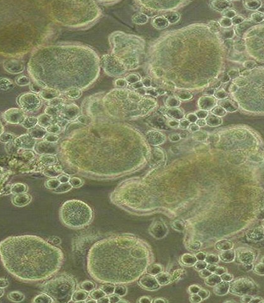Beta Glucans….not all are created equal.
False Claim:
False claim by Vaclav Vetvicka and AJ Lanigan is Beta glucan particulate particle size does not matter in the bioavailability and phagocytosis process of macrophages. In an April 22, 2020 Published Report that Vaclav Vetvicka reviewed, the study found “The particle size of glucan matters and its generally known that nanoparticles with a diameter of 1-2 microns are better absorbed [better bioavailability] than large-size particles.” See extensive “Micronized” positive research at www.betaglucan.org under “Micronization.”
Beta Glucan, Natures Secret, 3rd Edition, Vaclav Vetvicka, PhD, P153-154, 2015: “It is apparent that, in the case of macrophages and phagocytosis, size really does not matter.”
Beta Glucan Truth:
Han AB, Baruah K, “Structure-Functional Activity Relationship of B-Glucans from the Perspective of Immunomodulation: A Mini-Review,” Front. Immunol, Reviewed with article attribution by Vaclav Vetvica, DOI: 10.3389/fimmu.2020.00658 April 22, 2020. Quote: “Particle Size: The particle size of glucan matters and its generally known that nanoparticles with a diameter 1-2 microns are better absorbed [more bioavailable] by macrophages than large-size particles.”
Zechner-Krpan V, Petravic-Tominac V, Galovic P, Galovic V, Filipovic-Grcic J, Srecec S, “Application of different drying methods on B-GlucaniIsolated from spent brewer’s yeast using alkaline procedure, ” U of Zagreb, Agriculturae Conspectus Scientificus, Vol 75, No 1 2010. Quote: “The macrophage phagocytosis is more enhanced by microparticulate B-glucan than by its aggregated form. …The particles having 1-2 µm [microns] in diameter are optimally phagocytized by macrophages.”
Pacheco P, White D, Sulchek T, “Effects of microparticle size and Fc density on macrophage phagocytosis.” PLoS One. 2013 Apr 22;8(4):e60989. PMID:23630577; PMCID:PMC363260 . Quote: “The percentage of phagocytic macrophages was found to be strongly dependent on both the particle size and the particle Fc density. Note: Fc is an antibody molecule known as the crystallizable fragment.
Champion JA, Walker A, Mitragotri S, “Role of particle size in phagocytosis of polymeric microspheres.” Pharmaceutical research 25: 1815–1821 2008. PMIC 18373181, PMC 2793372. Quote: “Particles possessing diameters of 2-3 microm exhibited maximal phagocytosis and attachment… . “
Freitas Jr, RA, “15.4.3.1 Phagocytes, Phagocytosis, and the RES – Macrophages;” Nanomedicine, Volume IIA: Biocompatibility, Landes Bioscience, Georgetown, TX 2003. Quote: “The presence and activity of phagocytes is particularly related to the presence of small particles. …Maximum stimulus occurs at average particle sizes in the 0.1-2.0 [micron] range… “
Jordan F, Hunter Jr. KW, Gault R, “Method for preparing small particle size glucan in a dry material,” U.S. Patent 6,476,003. November 2002. Quote: “…The greater percentage phagocytosis demonstrates the enhanced activity of the macrophage and the small particle size glucan’s ability to activate the immune system.” http://www.unr.edu/mmi/participating-faculty/kenneth-hunter
False Claim:
Beta Glucan, Natures Secret, 3rd Edition, Vaclav Vetvicka, PhD, P153-154, 2015: 2015:,“…some companies are selling micronized glucans that are often accompanied by claims that they are more bioavailable. It might be true. It is unfortunate that even after more than 40 years of extensive research, there is no published scientific evidence to support this statement.”
Beta Glucan Truth:
Beta glucan when micronized (1 to 4 microns) is more bioavailable and more bioactive than large particle globular/agglomerated/aggregated (5 to 500 microns) size beta glucan particles. Taber’s Medical Dictionary defines bioavailability as “the rate and extent to which an active drug or metabolite enters the general circulation, permitting access to the site of action. The level of bioactivity is important since if a product is not absorbed by the body, it will not produce the desired effect and the better the bioactivity the faster the desired effect is obtained.
Pacheco P et al 2013, PLoS One. 2013 Apr 22; 8(4): e60989. PMID: 23630577 ; PMCID:PMC363260 . Quote:”smaller opsonized microparticles (0.5 µm to 2 µm) can deliver bio-active substances to a greater percentage of the macrophage population. (µm =microns)
Zechner-Krpan V, et a, ,2010. Quote: “…Biological activity of B-glucan can be improved by reducing the size of its particles. …The particles having 1-2 µm [microns] in diameter are optimally phagocytized by macrophages.”
Jordan F, Hunter Jr. KW, Gault R, “Method for preparing small particle size glucan in a dry material,” U.S. Patent 6,476,003. November 2002. Quote: “…The greater percentage phagocytosis demonstrates the enhanced activity of the macrophage and the small particle size glucan’s ability to activate the immune system.”
Beta Glucan Particle Size – Smaller more Effective: Donzis B. A.; Substantially purified beta (1,3) finely ground yeast cell wall glucan composition with dermatological and nutritional uses; U.S. Patent 5576015; 1996. Quote: “Upon oral administration, the smaller or finer particle sized glucan is more quickly dissolved in the gastrointestinal tract and consequently, more readily absorbed.”
False Claim:
Macrophages and Neutrophils do not have receptor sites for beta glucan 1 to 2 microns in size but only several molecules in size.
Beta Glucan, Natures Secret, 3rd Edition, Vaclav Vetvicka, PhD, P153-154: 2015:
“Some retailers and even manufacturers are using pseudoscientific claims. They may claim the advantage of extra-small size, suggesting that cells involved in internalization and subsequent transfer of glucan, such as dendritic cells, macrophages and neutrophils, have ‘receptors for the beta glucans approximately 1-2 microns in size.’ …It is clear that these salesmen do not realize what they are talking about, as macrophages have glucan receptors the size of only several molecules. ..Yet they are able to phagocytose material of more than 20% of their own size …”.
False Claim:
WebMD at present (08/20/20) is mistakenly stating a company, indicating Nutritional Scientific Corporation (NSC) and its MG Beta Glucan, is in error with no reliable evidence stating, …” only beta glucan taken orally that is micronized by a patented process to produce glucan of 1 micron or less can be absorbed,” but the statement is misleading and false. No source or evidence for this false statement is given by WebMD and after being notified, no response from WebMD has been received by NSC.
Beta Glucan Truth:
Jordan F, Hunter Jr. KW, Gault R, “Method for preparing small particle size glucan in a dry material,” U.S. Patent 6,476,003. November 2002: “As the glucan re-aggregates to a size of greater than one micron in diameter, some of the beneficial effect of the glucan is not achieved because the macrophage receptors are not activated as readily by glucan greater than one micron in diameter because the receptor size on corresponding cells and molecules that accept the glucan is generally about one micron in size.
Dr. Paul Clayton, former Senior Scientific Advisor to the UK government’s Committee on the Safety of Medicines and Research Director of Medical Nutrition Matters, a post-graduate course in Oxford to teach nutrition to GPs and other health care providers states, “Size matters. The molecular size of the beta glucans also appears to be important. Particles of approximately 2-6 microns in size appear to be most effective.”
False Claim: Beta Glucan from Oats and Barley (Beta 1,4 Glucan) is beneficial in cholesterol management, but not Beta 1,3/1,6 Glucan.
Beta Glucan Truth: Robert Nicolosi, et al ,”Cholesterol Benefits from Beta 1,3/1,6 Glucan Purified from Yeast Cell Wall,” Nutrition and Infection Laboratory, Harvard Medical School; American Journal of Clinical Nutrition, Vol. 70, No. 2, 208-212, August 1999. PubMed 10426696 Quote: “ The yeast-derived ß-glucan fiber lowered total cholesterol and raised HDL-cholesterol concentrations significantly. …Because higher HDL-cholesterol concentrations are associated with a reduced risk of developing coronary artery disease, there may be unique benefits of using the yeast-derived ß-glucan, and perhaps psyllium, rather than the oat products.“
False Claim:
WebMD at present (08/20/20) is mistakenly stating a company, indicating Nutritional Scientific Corporation (NSC) and its MG Beta Glucan, is in error with no reliable evidence stating, …” only beta glucan taken orally that is micronized by a patented process to produce glucan of 1 micron or less can be absorbed,” but the statement is misleading and false. No source or evidence for this false statement is given by WebMD and after being notified, no response from WebMD has been received by NSC.
Beta Glucan Truth:
Frank Jordan, Research Director for Nutritional Scientific Corporation, stated without reservation the claim by WebMD has not been made by NSC nor is it found in U.S. Patent 6,476,003 apparently referred to by WebMD on which he is Co-Inventor; thus the WebMD claim with regard to NSC is false.
What is stated in U.S. Patent 6,476,003 in which Frank Jordan was Co-Inventor with Kenneth W. Hunter ScD and Ruth Gault PhD from the University of Nevada School of Medicine, Dept. of Microbiology is Quote: “…. As the glucan re-aggregates to a size of greater than one micron in diameter, some of the beneficial effect of the glucan is not achieved because the macrophage receptors are not activated as readily by glucan greater than one micron in diameter because the receptor size on corresponding cells and molecules that accept the glucan is generally about one micron in size.”
In further published research in the Letters in Applied Microbiology by Kenneth W. Hunter ScD et al from the U. of Nevada School of Medicine, Dept of Microbiology, the peer reviewed research (PubMed 123586685) stated, “…there was evidence that macrophages…, preferentially ingest particles in the 1-2-µ [microns] diameter size range. … Although both aggregated and microparticulate glucans enhanced peritoneal macrophage activation when administered orally in mice, the microparticulate glucan was significantly better than the aggregated form“ Although notified with reliable evidence of the WebMD error, to date WebMD regretably and without explanation has not corrected the misstatement as it pertains to Nutritional Scientific Corporation (NSC) containing the false information.

Better Way Health / Transfer Point #300 Beta Glucan – particles 50-100+ microns (macrophages are shown – 5-15 microns in diameter)

NSC MG Beta Glucan with macrophages Both MG Beta Glucan 3-5 microns (macrophages 5-15 microns)
Clarification:
The JANA journal is published by the American Nutraceutical Association and not the American Medical Association (AMA), the AMA having intense professional peer review of research presented in JAMA after review for research standards and lack of conflict of interests.
The American Medical Association publishes the Journal of the American Medical Association or JAMA; and has no association with the JANA publication. JANA research is not listed in PubMed, the U.S. National Institutes of Health (NIH) free digital archive of biomedical and life sciences journal literature – considered by researchers and healthcare professionals to be the gold standard resource for credible scientific studies.
Neutraceuticals World reports, [At JANA,] “The rigor of peer review is very low as a notable number of the authors of articles do, arguably, have a conflict(s) of interest.” – See more at http://www.nutraceuticalsworld.com/contents/view_online-exclusives/2008-01-01/the-american-nutraceutical-association-under-the-m
An example of potential conflict of interest involves V Vetvicka with many JANA articles on beta glucan while participating in “cooperation,” according to Vetvicka’s personal website, with Transfer Point – #300 glucan (owner: A.J. Lanigan), although undisclosed in JANA research or other articles promoting #300 glucan.